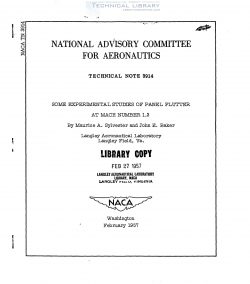naca-tn-3914
- Version
- 54 Downloads
- 944.80 KB File Size
- 1 File Count
- January 31, 2017 Create Date
- January 31, 2017 Last Updated
National Advisory Committee for Aeronautics, Technical Notes - Some Experimental Studies of Panel Flutter at Mach Number 1.3

Experimental studies of panel flutter were conducted at a Mach num-
ber of 1.3 to verify the existence of this phenomenon and to study the
effects of some structural parameters on the flutter characteristics.
Thin rectangular metal plates were used in these studies and were mounted
as a section of the tunnel wall. Nbst of the data were obtained by using
aluminum—alloy panels, althOugh a few steel, magnesium, and brass panels
were also used. Different materials with various thicknesses and
lengths were used to determine the effect of these parameters on panel
flutter. The experimental program consisted of three phases: (1) panels
clamped front and rear with tension, (2) initially buckled panels clamped
front.and rear, and (3) buckled panels clamped on all four edges.
Panel flutter was obtained under controlled laboratory conditions
and it was found that, at the flow conditions of these tests, increasing
tensile forces were effective in eliminating flutter, as were short-
ening the panels or increasing the bending stiffness. No apparent sys—
tematic trends in the flutter modes or frequencies could be observed,
and it is significant that the_panel flutter sometimes involved higher
modes and frequencies. The presence of a pressure differential between
the two surfaces of a panel was observed to have a stabilizing effect.
Initially buckled panels were more susceptible to flutter than panels
without buckling. Buckled panels with all four edges clamped were much
less prone to flutter than buckled panels clamped front and rear.
Many of the early German V-2 rockets failed during flight after
entering the supersonic speed range. After 60 or 70 failures, the con—
clusion was finally reached that many of these failures were caused by
failure of the skin covering, and, moreover, it was conjectured that
the skin failures were due to_a dynamic instability which was caused by
the air flow. This instability has been termed "panel flutter."
| File | Action |
|---|---|
| naca-tn-3914 Some Experimental Studies of Panel Flutter at Mach Number 1.3.pdf | Download |

Comment On This Post